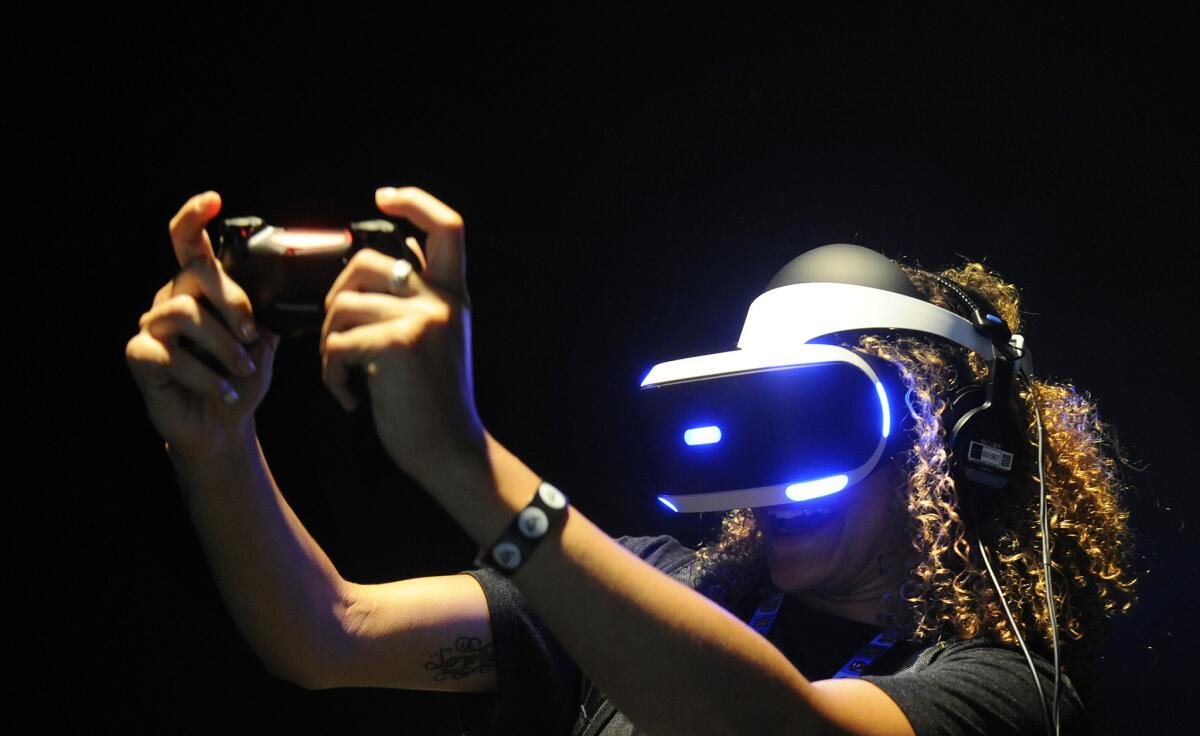The Player: In reality, Project Morpheus, Oculus Rift aren’t the most exciting things at E3

Sianna Hasenberg tries out Sony’s Project Morpheus at E3. Virtual reality headsets aren’t light.
Virtual reality was supposedly the future at the Electronic Entertainment Expo, the shiny new toy that was going to revolutionize gaming. But virtual reality has been the shiny new toy that was going to revolutionize gaming since Nintendo introduced the Virtual Boy in the mid-1990s.
Trust us, companies such as Sony and the Facebook-owned Oculus VR say, virtual reality is back.
Indeed, it’s entirely possible that by this time next year, two of the most promising headsets in the VR space, Sony’s Project Morpheus and the Oculus Rift, will come to market. Thus, virtual reality, and Microsoft’s HoloLens, which creates holographic images in a small field of view, were the media darlings of E3.
I went to E3 viewing virtual reality with arms-folded suspicion. At times, I was charmed. Once, while a playing a first-person shooter, I stumbled and nearly fell. Often, I struggled to get headsets on or off over my glasses. I was even advised to not wear the glasses, but my vision is horrible and everything was slightly blurry.
For me, the most exciting trend at E3 was not VR. Instead, if one paid close attention to the games on the floor, it was clear that video game designers are continuing to push the medium into more honest, diverse and emotional spaces.
Take “Beyond Eyes,” an in-development independent game for Microsoft’s Xbox One console that’s due for release this summer. It features a young girl who lost her sight and ventures outside the safety of her home after her best friend, her cat, goes missing.
The game screen before me was largely white. With each hesitant step of the girl, flowers and grass slowly sprang to life, as if drawn by an invisible paintbrush.
There wasn’t much else — I could hear a rustling of leaves, maybe a water fountain — but the game from Tiger & Squid resonates because it encourages the player to get inside the headspace of a child, Rae, and to prod her forward despite her uncertainty. The player will recognize the sound of a highway, but Rae will not; she will visualize it as an oppressive wall of blackness. It’s OK, it’s just a highway, you want to say to her, and then you remember that somewhere out in this world is a cat that she won’t be able to see, and every sound is a potential threat. I couldn’t get it out of my head.
The top games at E3 show us new ways to view the world. In “Beyond Eyes” it’s from the mind of a frightened child, and in “Unravel” it’s as a tiny piece of yarn trying to stitch together the memories of an aging woman. Then, there’s an elderly king in “King’s Quest” relaying tall tales to his granddaughter. Weirder still, there’s a sad pillow in “Wattam” who’s bummed out because all its friends just want to sleep.
Games like “Beyond Eyes” and Funomena’s in-development “Wattam” are emblematic of a video game medium in transition, one increasingly split between big-budget and complex blockbuster wannabes — here’s hoping you have 50 hours to complete one — and independent developers who believe an interactive medium is best when it’s accessible and elicits an emotional response. I wanted to hug every one of “Wattam’s” characters, and that sensation was achieved without an additional pair of glasses.
That doesn’t mean it’s all emotion. “Beyond Eyes,” for instance, fiddles with our depth perception — no high-priced goggles needed. Which raises the question: Are goggles needed?
Fun? Yes. A necessity? At least not right now.
Still, there’s good news: Unlike past E3s, this year I didn’t want to vomit after playing a virtual reality title. Progress.
Sony does have a lovely VR demo in which the player sporting the Morpheus becomes a giant monster, destroying buildings just by leaning forward, left or right. Others can play too; those not wearing the headset join in via an old-timey controller and a television and try to throw objects at the monster. It’s a party game, and it works great in a quick 5-minute play session.
Better still: Uber Entertainment’s “Wayward Sky,” billed as a “look and click” game in which Morpheus wearers direct a character around a world with a move of the head.
Playful Corp. has a game in development for the Rift dubbed “Lucky’s Tale,” and this is the VR game I’d most like to spend more time with. It’s a “Super Mario Bros.”-inspired game where a little fox hops around a gloriously bright world in which forests look like they’re constructed of candy.
Insomniac Games has a tense Rift title in “Edge of Nowhere.” In this one, an adventurer explores an icy tundra while supernatural elements beckon.
Here’s what’s exciting about them, and it’s not necessarily the VR. The aforementioned games are all relatively accessible.
They utilize one or two buttons, not a dozen-plus, and the world is explored with a turn of the head. Not bad for a device that, at minimum, will require a high-end PC (Oculus says to expect to spend about $1,500 for a PC and headset, if you don’t already have a top-of-the-line computer), or a $400 PlayStation 4. Then there’s the as-yet-to-be-determined costs of the headset.
Yet for all the horsepower needed, VR games are dialing things down. At E3, where guests are wooed by scantily clad women in “Ghostbusters” outfits and the convention floor was aptly summed up at a Sunday evening news conference by Bethesda executive Pete Hines as “blood, guts and stuff blowing up,” little Lucky the fox was a charmer.
“Lucky’s Tale,” says Playful Chief Executive Paul Bettner, “takes a step back into simplicity.”
Lessons in terms of what kind of games work in VR are still being learned. Standing up while playing a VR game is a no-go, and it usually takes at least one other person to a get a Rift or a Morpheus headset on or off. When VR is as light and simple as a pair of glasses, I’ll be convinced. As Bettner said, “In VR, comfort is the most important thing.”
Thus, fast-moving action games in a VR space are dicey. Nate Mitchell, an executive at Oculus, said the company learned that early.
“The main thing that needs to be avoided right now is hard-core locomotion, especially driven by the user in a highly aggressive way,” he says. “Let’s say you’re playing ‘Call of Duty’ in a Rift. It is going to be an uncomfortable experience. Things are flying by you incredibly quickly. You brain is not designed to process it. We don’t move naturally like that through the world, so it tends to be jarring.”
The VR games I enjoyed were ones with generally slow-moving characters or objects. When I walked away from VR demos, it wasn’t with a sensation that 360-degree immersion will change my life — in fact, I prefer to know I can keep an eye on my cat or check email while I’m playing a game or watching a movie at home — but I was instead taken with how the best VR demos were essentially pick-up-and-play games.
“Everyone thinks of it as this new complicated high-tech thing that’s coming,” says Sony’s VR guru, Richard Marks. “To make it is quite high-tech and complicated, but to develop for it isn’t so high-tech. To experience it, it isn’t at all.”
There’s no massive learning curve when games are largely motion-controlled. Video game controllers are starting to seem relatively outdated in a touchscreen-based universe, and if five or 10 years from now VR becomes cheap, light and a comfortable fit around my glasses, count me in.
Twitter: @Toddmartens
More to Read
The biggest entertainment stories
Get our big stories about Hollywood, film, television, music, arts, culture and more right in your inbox as soon as they publish.
You may occasionally receive promotional content from the Los Angeles Times.











